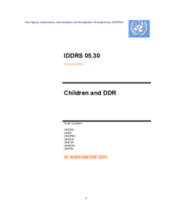This module on children and disarmament, demobilization and reintegration (DDR) is based on relevant provisions of international law, field experience and lessons learned by UNICEF over the past 15 years in its programmes for the prevention of recruitment and the demobilisation and reintegration of children affected by armed conflict.
There is a growing international consensus that the forced or compulsory recruitment of children – girls and boys under the age of 18, and their use in hostilities by both armed forces and armed groups, is illegal and one of the worst forms of child labour. The recruitment and use of children under 15 is a war crime. This consensus is expressed in a comprehensive set of international legal instruments, such as the Optional Protocol to the Convention on the Rights of the Child and the Rome Statute establishing the International Criminal Court, and is reinforced by a series of UN Security Council resolutions.
Unlike adults, children cannot legally be recruited; therefore, measures which aim to prevent their recruitment, or which attempt to reintegrate them into their communities, should not be viewed as a routine component of peacemaking but as an attempt to prevent or redress a violation of children’s human rights. This means that child DDR is not analogous to that for adults. Rather, it is a specific process with its own imperatives, several of which are fundamentally different from adult demobilization programmes.
Child DDR requires that the demobilization (or ‘release’) and reintegration of children, especially girls, be pursued at all times, even during a conflict, and that actions to prevent child recruitment should be continuous. When DDR exercises have made the presentation of a weapon for disarmament as a criterion for eligibility for DDR, children, especially girls, have been excluded – whether intentionally or not. Because children are associated with armed groups in a variety of ways, not only as combatants, some may not have access to weapons. These children must still be considered child soldiers, released by the groups that recruited them, and receive reintegration support.
Child DDR has a different scope and timeframe from that for peacekeeping operations and national reconstruction efforts. It must not wait until a mechanism for adult DDR is established. Efforts should be made to ensure that child DDR is not contingent on adult DDR or the conclusion of broader security sector reform (SSR) and power sharing negotiations, because interdependency between child and adult DDR programmes has negative consequences for children associated with armed forces and groups. Children should not find themselves pawns, recruited in order to swell the ranks of armed groups who have over-reported their numbers as a means to influence power sharing agreements. It is also essential to protect child DDR structures and mechanisms from setbacks in SSR reform, including a lack of funding, so that child DDR mechanisms continue to operate even if progress on adult DDR is slow. Equally, because children can be associated with armed forces and groups in a variety of ways, child-specific DDR mechanisms should remain in place after national reintegration of adult soldiers is complete. This will ensure that all children associated with armed forces and groups – not just those who fought as combatants – can benefit from the process.
Peace processes offer an opportunity to highlight the needs of children affected by armed conflict, and their rights should be identified as an explicit priority in peacemaking, peacebuilding and conflict resolution processes both in the peace agreement as well as in DDR plans. The commitment to stop the recruitment of children and to release children from armed forces and groups, with specific attention to girls, should be stated within peace agreements.
Child-specific reintegration shall allow a child to access education, a livelihood, life skills and a meaningful role in society. The socio-economic and psychosocial aspects of reintegration for children in global DDR programming and budgeting are central. Successful reintegration requires long term funding of child protection agencies and programmes to ensure continuous support for education and training for children and essential follow-up/monitoring once they return. For sustainability, and to ensure the whole community can benefit from a child’s return and reintegration while avoiding tension, stigmatization or envy when a child is returned to a village with a reintegration package containing material goods that are unavailable to others, it is based in broader community development processes. It is neither possible nor desirable to suggest a scripted intervention, so each programme needs to be context-specific and developed and managed to be sustainable.
©Inter-agency Disarmament, Demobilization and Reintegration Working Group (IDDRWG)

